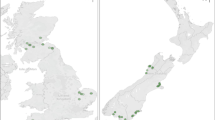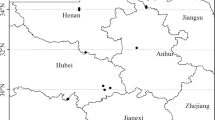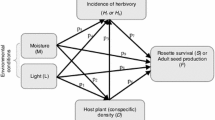Abstract
It has long been hypothesized that biotic interactions, including herbivory, are most intense at lower latitudes. However, this generalization has recently been challenged with studies showing that latitudinal gradients in damage may be rarer than previously believed. Additionally, most studies have focused on herbivory of native species, so it remains unknown whether natives and exotics follow similar patterns. This study compares rates of aboveground herbivory of multiple native and non-native Asteraceae across a latitudinal gradient, with a more detailed investigation of a focal exotic, Cirsium arvense. Herbivory of multiple tissue types was quantified for all species across an 815 km transect in Ontario, Canada. The native Asteraceae included in the survey typically experienced a decline in folivory with increasing latitude. Herbivory patterns for the exotic species were less clear; while most experienced high damage at the southernmost site, some also experienced high damage rates at mid-latitudes. For the focal species C. arvense, leaf and stem herbivory declined with increasing latitude, although seed damage showed strong regional variation across the invaded range. These results show that latitudinal variation in herbivory is highly dependent on the plant species being investigated, the tissue type being measured, and the type of herbivore(s) causing the damage. In some cases, populations in marginal areas might benefit from reduced damage by some groups of herbivores. In other cases, factors such as the availability of suitable habitat, the biology of specific enemies, and the origin of the host plant may override the influence of latitude on host performance.






Similar content being viewed by others
References
Alexander HM, Price S, Houser R, Finch D, Tourtellot M (2007) Is there reduction in disease and pre-dispersal seed predation at the border of a host plant’s range? Field and herbarium studies of Carex blanda. J Ecol 95:446–457. doi:10.1111/j.1365-2745.2007.01228.x
Angermann HJ (1986) Ecological differentiation of the Tephritid flies Xyphosia miliaria and Orellia ruficauda (Diptera: Tephritidae) in the flower heads of Canada thistle (Cirsium arvense). Entomol Gen 11:249–261
Anstett DN, Naujokaitis-Lewis I, Johnson MTJ (2014) Latitudinal gradients in herbivory on Oenothera biennis vary according to herbivore guild and specialization. Ecology 95:2915–2923
Bach CE (1994) Effects of a specialist herbivore (Altica subplicata) on Salix cordata and sand dune succession. Ecol Monogr 64:423–445
Baldwin DJB, Desloges JR, Band LE (2000) Physical geography of Ontario. In: Perera AH, Euler DE, Thompson ID (eds) Ecology of a managed terrestrial landscape: patterns and processes of forest landscapes in Ontario. University of British Columbia Press, Vancouver
Bolser RC, Hay ME (1996) Are tropical plants better defended? Palatability and defenses of temperate vs. tropical seaweeds. Ecology 7:2269–2286
Bradley BA, Blumenthal DM, Wilcove DS, Ziska LH (2010) Predicting plant invasions in an era of global change. Trends Ecol Evol 25:310–318. doi:10.1016/j.tree.2009.12.003
Clausen JD, Keck D, Hiesey WM (1948) Experimental studies on the nature of species. III. Environmental responses of climatic races of Achillea. Carnegie Institute of Washington, Washington, DC
Coley PD, Aide TM (1991) Comparison of herbivory and plant defenses in temperate and tropical broad-leaved forests. In: Price PW, Lewinsohn TM, Fernandes GW, Benson WW (eds) Plant–animal interactions: evolutionary ecology in tropical and temperate regions. Wiley, New York, pp 25–49
Coley PD, Barone JA (1996) Herbivory and plant defenses in tropical forests. Annu Rev Ecol Syst 27:305–335
Cripps MG, Gassmann A, Fowler SV, Bourdôt GW, McClay AS, Edwards GR (2011) Classical biological control of Cirsium arvense: lessons from the past. Biol Control 57:165–174. doi:10.1016/j.biocontrol.2011.03.011
Darling E, Samis KE, Eckert CG (2008) Increased seed dispersal potential towards geographic range limits in a Pacific coast dune plant. New Phytol 178:424–435. doi:10.1111/j.1469-8137.2007.02349.x
Dawson W, Burslem DFRP, Hulme PE (2009) Herbivory is related to taxonomic isolation, but not to invasiveness of tropical alien plants. Divers Distrib 15:141–147. doi:10.1111/j.1472-4642.2008.00527.x
Early R, Sax DF (2014) Climatic niche shifts between species’ native and naturalized ranges raise concern for ecological forecasts during invasions and climate change. Glob Ecol Biogeogr 23:1356–1365. doi:10.1111/geb.12208
Elton CS (1958) The ecology of invasions by animals and plants. The ecology of invasions by animals and plants. Wiley, New York
Feeny P (1976) Plant apparency and chemical defense. In: Wallace JW, Mansell RL (eds) Recent advances in phytochemistry. Plenum Press, New York, pp 1–40
Frenzel M, Eber S, Klotz S, Brandl R (2000) Ecological comparisons across geographical distributions: the thistle gall fly Urophora cardui (Diptera: Tephritidae) on two different Cirsium hosts. Eur J Entomol 97:183–189
Harvey KJ, Nipperess DA, Britton DR, Hughes L (2012) Australian family ties: Does a lack of relatives help invasive plants escape natural enemies? Biol Invasions 14:2423–2434. doi:10.1007/s10530-012-0239-4
Harvey KJ, Nipperess DA, Britton DR, Hughes L (2013) Does time since introduction influence enemy release of an invasive weed? Oecologia 173:493–506. doi:10.1007/s00442-013-2633-8
Hatcher MJ, Dunn AM (2011) Parasites in ecological communities: from interactions to ecosystems. Cambridge University Press, Cambridge
Hawkes CV (2007) Are invaders moving targets? The generality and persistence of advantages in size, reproduction, and enemy release in invasive plant species with time since introduction. Am Nat 170:832–843. doi:10.1086/522842
Huntly N (1991) Herbivores and the dynamics of communities and ecosystems. Annu Rev Ecol Syst 22:477–503. doi:10.1146/annurev.es.22.110191.002401
Jonas T, Rixen C, Sturm M, Stoeckli V (2008) How alpine plant growth is linked to snow cover and climate variability. J Geophys Res. doi:10.1029/2007jg000680
Jump AS, Woodward FI (2003) Seed production and population density decline approaching the range-edge of Cirsium species. New Phytol 160:349–358. doi:10.1046/j.1469-8137.2003.00873.x
Kambo D, Kotanen PM (2014) Latitudinal trends in herbivory and performance of an invasive species, common burdock (Arctium minus). Biol Invasions 16:101–112. doi:10.1007/s10530-013-0506-z
Keane RM, Crawley MJ (2002) Exotic plant invasions and the enemy release hypothesis. Trends Ecol Evol 17:164–170
Kirkpatrick M, Barton NH (1997) Evolution of a species’ range. Am Nat 150:1–23
Kozlov MV (2007) Losses of birch foliage due to insect herbivory along geographical gradients in Europe: A climate-driven pattern? Clim Change 87:107–117. doi:10.1007/s10584-007-9348-y
Lalonde RG (1991) Oviposition behavior of Orellia ruficauda on Canada thistle. Dissertation, Simon Fraser University
Larson GE, Wittig TA, Higgins KF, Turnipseed B, Gardner DM (2005) Influence of biocontrol insects on Canada thistle: seed production, germinability, and viability. Prairie Nat 37:85–100
Lee Y, Kotanen PM (2014) Differences in herbivore damage and performance among Arctium minus (burdock) genotypes sampled from a geographic gradient: a common garden experiment. Biol Invasions. doi:10.1007/s10530-014-0737-7
Levine JM, Adler PB, Yelenik SG (2004) A meta-analysis of biotic resistance to exotic plant invasions. Ecol Lett 7:975–989. doi:10.1111/j.1461-0248.2004.00657.x
Liu H, Stiling P (2006) Testing the enemy release hypothesis: a review and meta-analysis. Biol Invasions 8:1535–1545. doi:10.1007/s10530-005-5845-y
Maron JL, Crone E (2006) Herbivory: effects on plant abundance, distribution and population growth. Proc R Soc B 273:2575–2584. doi:10.1098/rspb.2006.3587
Maron JL, Vila M (2001) When do herbivores affect plant invasion? Evidence for the natural enemies and biotic resistance hypotheses. Oikos 95:361–373
Mitchell CE et al (2006) Biotic interactions and plant invasions. Ecol Lett 9:726–740. doi:10.1111/j.1461-0248.2006.00908.x
Moles AT, Bonser SP, Poore AGB, Wallis IR, Foley WJ (2011a) Assessing the evidence for latitudinal gradients in plant defence and herbivory. Funct Ecol 25:380–388. doi:10.1111/j.1365-2435.2010.01814.x
Moles AT et al (2011b) Putting plant resistance traits on the map: a test of the idea that plants are better defended at lower latitudes. New Phytol 191:777–788. doi:10.1111/j.1469-8137.2011.03732.x
Moore RJ (1975) The biology of Canadian weeds. 13. Cirsium arvense (L.) Scop. Can J Plant Sci 55:1033–1048
Pearse IS, Hipp AL (2009) Phylogenetic and trait similarity to a native species predict herbivory on non-native oaks. Proc Natl Acad Sci USA 106:18097–18102. doi:10.1073/pnas.0904867106
Pennings SC, Silliman BR (2005) Linking biogeography and community ecology: latitudinal variation in plant–herbivore interaction strength. Ecology 86:2310–2319
Pennings SC et al (2007) Latitudinal variation in plant–herbivore interactions in European salt marshes. Oikos 116:543–549. doi:10.1111/j.2007.0030-1299.15591.x
Pennings SC, Ho CK, Salgado CS, Wieski K, Dave N, Kunza AE, Wason EL (2009) Latitudinal variation in herbivore pressure in Atlantic Coast salt marshes. Ecology 90:183–195
Salazar D, Marquis RJ (2012) Herbivore pressure increases toward the equator. PNAS 109:12616–12620
Schemske DW, Mittelbach GG, Cornell HV, Sobel JM, Roy K (2009) Is there a latitudinal gradient in the importance of biotic interactions? Annu Rev Ecol Evol Syst 40:245–269. doi:10.1146/annurev.ecolsys.39.110707.173430
Sexton JP, McIntyre PJ, Angert AL, Rice KJ (2009) Evolution and ecology of species range limits. Annu Rev Ecol Evol Syst 40:415–436. doi:10.1146/annurev.ecolsys.110308.120317
Tiley GED (2010) Biological Flora of the British Isles: Cirsium arvense (L.) Scop. J Ecol 98:938–983. doi:10.1111/j.1365-2745.2010.01678.x
Torchin ME, Mitchell CE (2004) Parasites, pathogens, and invasions by plants and animals. Front Ecol Environ 2:183–190
Van der Putten WH, Macel M, Visser ME (2010) Predicting species distribution and abundance responses to climate change: why it is essential to include biotic interactions across trophic levels. Philos Trans R Soc Lond B Biol Sci 365:2025–2034. doi:10.1098/rstb.2010.0037
Vaupel A, Matthies D (2012) Abundance, reproduction, and seed predation of an alpine plant decrease from the center toward the range limit. Ecology 93:2253–2262
Voss EG (1996) Michigan Flora Part III. University of Michigan Press, Ann Arbor
Warton DI, Hui FKC (2011) The arcsine is asinine: the analysis of proportions in ecology. Ecology 92:3–10
Warwick SI, Black L (1982) The biology of Canadian weeds. 52. Achillea millefolium L. s.l. Can J Plant Sci 62:163–182
Woods EC, Hastings AP, Turley NE, Heard SB, Agrawal AA (2012) Adaptive geographical clines in the growth and defense of a native plant. Ecol Monogr 82:149–168
Zhang Y, Adams J, Zhao D (2011) Does insect folivory vary with latitude among temperate deciduous forests? Ecol Res 26:377–383. doi:10.1007/s11284-010-0792-1
Ziska LH, Faulkner S, Lydon J (2004) Changes in biomass and root: shoot ratio of field-grown Canada thistle (Cirsium arvense), a noxious, invasive weed, with elevated CO2: implications for control with glyphosate. Weed Sci 52:584–588. doi:10.1614/ws-03-161r
Acknowledgments
This research was supported by the Natural Sciences and Engineering Research Council of Canada (NSERC). We would like to thank L. Cassin, L. A. Goodine, L. Hu, A. Kamath, J. O’Connell, and K. Robert for assistance in the field and lab, and Algonquin Provincial Park for permitting access.
Funding
This study was funded by the Natural Sciences and Engineering Research Council of Canada (NSERC).
Author information
Authors and Affiliations
Corresponding author
Ethics declarations
Conflict of interest
The authors declare that they have no conflict of interest.
Additional information
Communicated by Scott J. Meiners.
Electronic supplementary material
Below is the link to the electronic supplementary material.
Rights and permissions
About this article
Cite this article
Nunes, K.A., Cassin, C.M. & Kotanen, P.M. Variation in herbivory along a latitudinal gradient for native and exotic Asteraceae . Plant Ecol 217, 481–493 (2016). https://doi.org/10.1007/s11258-016-0593-x
Received:
Accepted:
Published:
Issue Date:
DOI: https://doi.org/10.1007/s11258-016-0593-x




